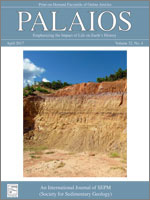Mean seasonal extreme temperatures on the seafloor calculated from the shell δ18O of the scallop Placopecten clintonius from the basal part of the early Pliocene Sunken Meadow Member (Yorktown Formation) in Virginia are very similar to those from the same horizon at the latitude of Cape Hatteras in North Carolina (∼ 210 km to the south). The lowest and highest temperatures calculated from each shell (using δ18Oseawater = 0.7‰) give mean values for winter and summer of 8.4 ± 1.1 °C (± 1σ) and 18.2 ± 0.6 °C in Virginia, and 8.6 ± 0.4 °C and 16.5 ± 1.1 °C in North Carolina (respective median temperatures: 13.3 °C and 12.6 °C). Patterns of ontogenetic variation in δ18O, δ13C and microgrowth increment size indicate summer water-column stratification in both areas, with summer surface temperatures perhaps 6 °C higher than on the seafloor. The low winter paleotemperatures in both areas are most simply explained by the greater southward penetration of cool northern waters in the absence of a feature equivalent to Cape Hatteras. The same current configuration but a warmer general climate can account for the high benthic seasonal range (over 15.0 °C in some cases) but warmer median temperatures (15.7–21.3 °C) derived from existing δ18O data from scallops of the higher Yorktown Formation (using δ18Oseawater = 0.7‰ for the upper Sunken Meadow Member and δ18Oseawater = 1.1‰ for the mid-Pliocene Rushmere, Morgarts Beach, and Moore House members). Existing δ18O data from the infaunal bivalve Mercenaria of the Rushmere Member yields a similarly high median temperature (21.6 °C) but a low seasonal range (9.2 °C), pointing to the periodic influence of warm currents, possibly at times when the Gulf Stream was exceptionally vigorous.
How to translate text using browser tools
1 April 2017
ISOTOPIC TEMPERATURES FROM THE EARLY AND MID-PLIOCENE OF THE US MIDDLE ATLANTIC COASTAL PLAIN, AND THEIR IMPLICATIONS FOR THE CAUSE OF REGIONAL MARINE CLIMATE CHANGE
ANDREW L.A. JOHNSON,
ANNEMARIE VALENTINE,
MELANIE J. LENG,
HILARY J. SLOANE,
BERND R. SCHÖNE,
PETER S. BALSON
ACCESS THE FULL ARTICLE
It is not available for individual sale.
This article is only available to subscribers.
It is not available for individual sale.
It is not available for individual sale.
<
Previous Article
|

PALAIOS
Vol. 32 • No. 4
April 2017
Vol. 32 • No. 4
April 2017




